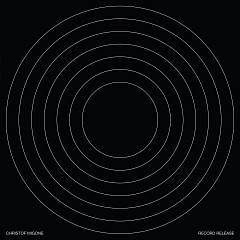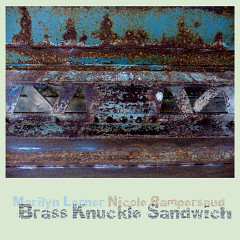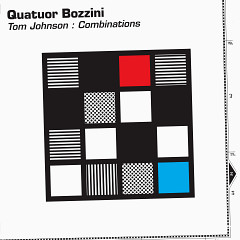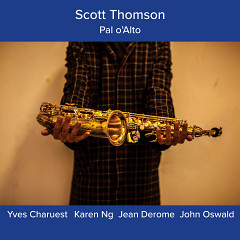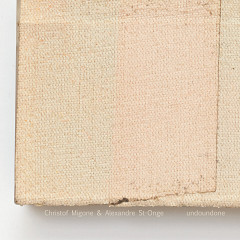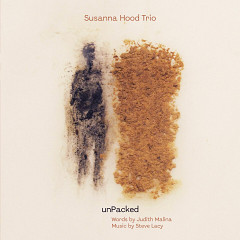… Navigations is a superb way to hear Lucier as he expands out of the Western art music tradition. — Bandcamp Daily, USA
This album, documenting a 2015 Quatuor Bozzini concert devoted to the late ultraminimalist, is a commendable addition to his difficult-to-record legacy. — Sequenza 21, USA
Prix Opus 2020-21: Album de l’année — Finaliste
“It is not enough just to play the right notes at the right time in the right way; one must also have the right consciousness. It places the performer in the role of explorer of the interior in order to produce, and being still in order to be active.”
These words, spoken by Pauline Oliveros, remind us of how fundamental an influence Alvin Lucier has had on the development of new music and its interpretation; they remind us of our role as explorers of sound, and of the irresistible appeal that Lucier’s world has always had for our quartet. We have had the pleasure and honour of working with Alvin on several occasions, playing his music even more often. When he asked us in the winter of 2020 to release recordings of a Montréal concert from 2015, we decided to devote a new album to this music. It is with excitement that we now dedicate this disc to him! — Isabelle Bozzini
- Composer(s): Alvin Lucier
- Performer(s): Bozzini Quartet, Clemens Merkel, Alissa Cheung, Stéphanie Bozzini, Isabelle Bozzini
- Graphic design: Fabrizio Gilardino
- SODEC
CD (CQB 2128, 2021)
- 1Disappearances (1994), 16:46string quartetBozzini Quartet (Isabelle Bozzini, cello; Stéphanie Bozzini, viola; Alissa Cheung, violin; Clemens Merkel, violin)
- 2Group Tapper (2004), 5:16string quartetBozzini Quartet (Isabelle Bozzini, cello; Stéphanie Bozzini, viola; Alissa Cheung, violin; Clemens Merkel, violin)
- 3Unamuno (1994), 5:214 equal voicesBozzini Quartet (Isabelle Bozzini, cello; Stéphanie Bozzini, viola; Alissa Cheung, violin; Clemens Merkel, violin)
- 4Group Tapper (2004), 10:59string quartetBozzini Quartet (Isabelle Bozzini, cello; Stéphanie Bozzini, viola; Alissa Cheung, violin; Clemens Merkel, violin)
- 5Navigations for Strings (1992), 19:02string quartetBozzini Quartet (Isabelle Bozzini, cello; Stéphanie Bozzini, viola; Alissa Cheung, violin; Clemens Merkel, violin)
- Label: Collection QB
- CQB 2128
- 2021
- UCC 771028372829
- Total duration: 57:24
- 35 g
On the web
Download (CQB 2128_NUM, 2021)
- 1Disappearances (1994), 16:46string quartetBozzini Quartet (Isabelle Bozzini, cello; Stéphanie Bozzini, viola; Alissa Cheung, violin; Clemens Merkel, violin)
- 2Group Tapper (2004), 5:16string quartetBozzini Quartet (Isabelle Bozzini, cello; Stéphanie Bozzini, viola; Alissa Cheung, violin; Clemens Merkel, violin)
- 3Unamuno (1994), 5:214 equal voicesBozzini Quartet (Isabelle Bozzini, cello; Stéphanie Bozzini, viola; Alissa Cheung, violin; Clemens Merkel, violin)
- 4Group Tapper (2004), 10:59string quartetBozzini Quartet (Isabelle Bozzini, cello; Stéphanie Bozzini, viola; Alissa Cheung, violin; Clemens Merkel, violin)
- 5Navigations for Strings (1992), 19:02string quartetBozzini Quartet (Isabelle Bozzini, cello; Stéphanie Bozzini, viola; Alissa Cheung, violin; Clemens Merkel, violin)
- Label: Collection QB
- CQB 2128_NUM
- 2021
- UCC 771028372881
- Total duration: 57:24
Some recommended items
In the press
Review
Quatuor Bozzini, in Montréal, is one of the leading contemporary music ensembles, and a frequent collaborator with Lucier. As Isabelle Bozzini, a founding member of the quartet, describes, in the winter of 2020, Lucier asked if they would release the live recording of a 2015 concert of his music. Instead, the quartet decided to make an entirely new album. Bringing together echolocation ideas (there are two performances of Group Tapper) with explorations of frequencies in concert and conflict (Navigations), Navigations is a superb way to hear Lucier as he expands out of the Western art music tradition.
Best of 2021: New/Experimental Recordings
There are few composers whose music better fulfills the potentialities of the old saw “It’s not for everybody — then again it doesn’t try to be” than Alvin Lucier (1931—2021). This album, documenting a 2015 Quatuor Bozzini concert devoted to the late ultraminimalist, is a commendable addition to his difficult-to-record legacy.
2021 — Best Albums of the Year
Un ideale excursus nelle indagini microtonali e “concrete” del decano della sperimentazione sonora, qui applicate a un ensemble di soli strumenti ad arco: intuizioni tanto essenziali quanto pregnanti, rivolte all’ascolto profondo di una vasta e inesplorata fenomenologia sonora.
Review
Adding to its stellar reputation for commissioning and performing experimental notated works, Montréal’s Quatuor Bozzini (QB) interprets five compositions by American composer Alvin Lucier on Navigations. Barbed, dissonant and compelling at the same time, these variants on works by the 90-year-old sound explorer have as much in common with traditional string quartet repertoire as Cecil Taylor has with Lang Lang. Formed in 1999, QB’s members — violinists Alissa Cheung and Clemens Merkel, violist Stéphanie Bozzini and cellist Isabelle Bozzini — have fused into a single unit of multiple moving parts. There are no soloists per se, and faithful to Lucier’s vision the timbres often resemble those from a percussion ensemble rather than a string quartet.
This is especially true on Group Tapper where the resonations appear to be created from combining smacks from the bows’ frogs, col legno string slaps and raps on the instruments’ wood to create call-and-response. As hammering moves from one to all players, tempos accelerate, first to presto and vivace, then to metallic sounding prestissimo until the soundfield is crammed with percussive ruffs. While other tracks are devoted to more conventional string strategies, the jagged and near impenetrable tones remain, encompassing hints of detuned scordatura. Detours into wispy and near-vocalized expositions are there, although the concluding Navigations for Strings offers the most bellicose challenges. As the players’ parts combine with layered and thickened tones a horizontal, undulating theme is revealed that becomes a near static, almost unbreakable drone. The climax and respite arrives when the unison strained buzz gives way to single string vibrations.
Formerly QB has created exemplified programs of composition by Ana Sokolović and Phill Niblock among others. Navigations is another defining work.
Critique
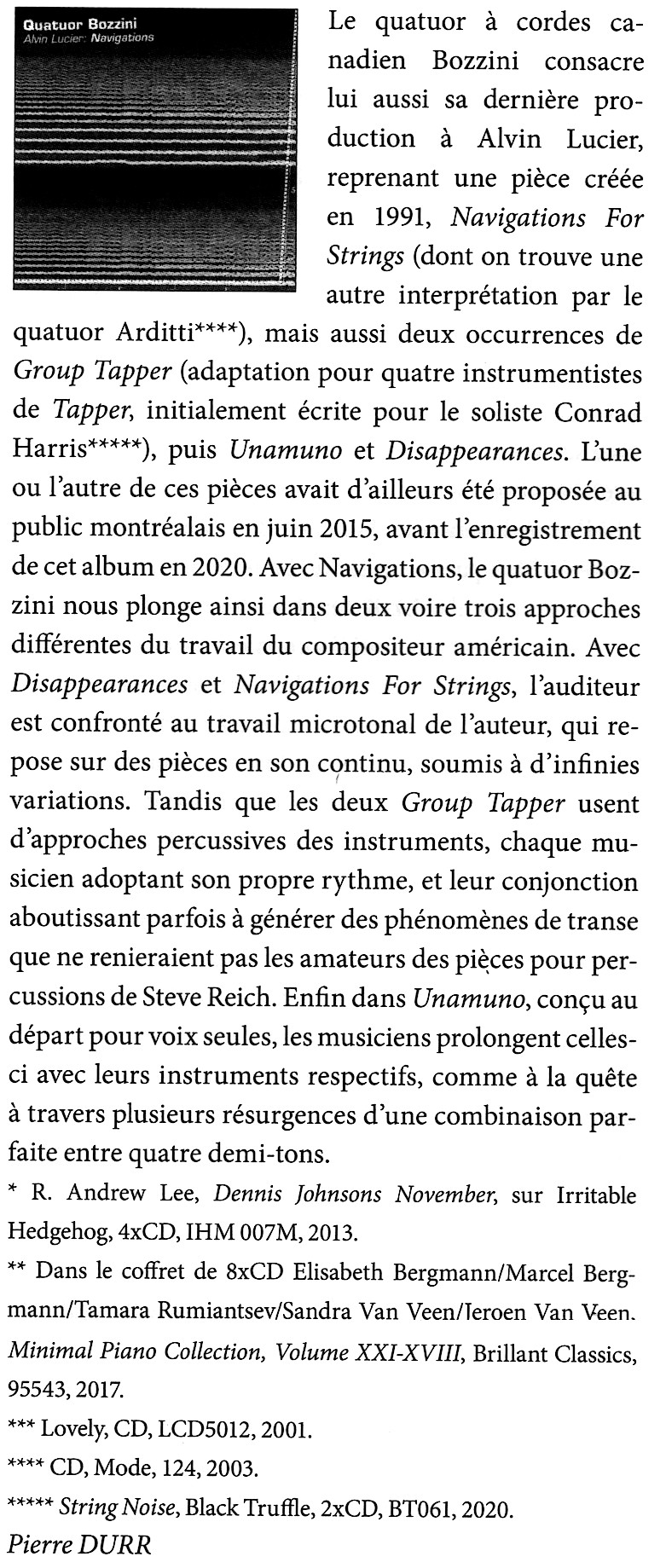
AMN Review
There have been many technical and technological innovations in music since 1945 but one of the most important aesthetic innovations has been in new ideas that focus on listening. Innovators like Pierre Schaeffer proposed the idea of reduced listening — an attitude in which sound is listened to for its own sake as a sound object, removed from its source. John Cage invited listeners to hear any sound as music. Pauline Oliveros encouraged listeners to actively experience all sounds through a practice she described as “deep listening”. These ideas all contributed to contemporary music’s focus on the experience of sound itself.
Alvin Lucier’s compositions and installations make use of sounds that are often the results of acoustic phenomena. His work focuses our attention and perception on the physical presence of sound interacting within a particular space. Performing Lucier’s compositions requires performers to learn to recognize, activate, play and interact with acoustic phenomena. The Quatuor Bozzini were clearly up for the challenge when they recorded Alvin Lucier: Navigations. The album opens with Disappearances, a piece that is a single note. That description may sound like it is minimalist to the extreme but to my ears it is a piece rich with development. You hear changes in weight and timbre as each string joins together in unison. The controlled motions of the string’s bows cause phasing and filtering of the sound. The tiny subtle changes in pitch causes beating which reveals pulsating difference tones. Each of these phenomena disappear into one another creating a feeling of movement and making the listener aware of the tiniest changes in pitch and timbre.
The album contains two realizations of Group Tapper, a piece that explores room acoustics by having the instrumentalists treat their instruments as percussion. The performers tap on their instruments in various places and reflect the sound coming from their instruments around the room. The recording engineer does a great job of making the room present on this album so that you can really hear how the group’s performance interacts with the room. Placed in between the two realizations of Group Tapper is for me the most striking piece on this recording, Unamuno. The piece was inspired by early twentieth century Spanish writer Miguel de Unamuno and it was originally written for voices. Unamuno is based around four pitches that are continuously arranged into different patterns. It has a probing and questioning kind of vibe to it. The Bozzini’s perform the piece with both strings and their voices. The result is absolutely stunning.
Review
Few top tier string quartets have been as devoted to experimental music as the Montréal ensemble Quatuor Bozzini, who routinely bring a stunning rigour to everything they play, whether the radical work of Swiss composer Jürg Frey or key Canadian figures such as Linda Catlin Smith, Cassandra Miller and Martin Arnold. This new album focuses on the music of Alvin Lucier, one of the most enduring and consequential sonic explorers of the last half-century, and the group’s razor-sharp precision and empathy helps bring the gripping psychoacoustics of his research into dynamic relief.
The album is bookended by two conventional yet open-ended string quartets, starting with the 1994 composition Disappearances originally written for Lucier’s students at Wesleyan University, and closing with the 1991 piece Navigations for Strings, previously recorded by Arditti. They feel like companion pieces. The first is built from harmonically rich, unison long tones that seem to float towards eternity, but eventually one musician slowly, almost imperceptibly, raises or lowers their individual pitch, incrementally followed by the others to produce acoustic beating with ever-changing rhythmic patterns, all contained within an immersive sustain. It’s the kind of work that could go on for hours, but this version clocks in at nearly 17 minutes, generating an immersive sonic experience at the heart of Lucier’s ongoing fascination with the science of sound.
In between the group perform two iterations of the 2004 piece Group Tapper, an adaptation of a piece written for violinist Conrad Harris — and recently featured in an hour long workout by his String Noise duo on a Black Truffle album — in which the musicians thwack at the bodies of their instruments with the butt end of a bow. Each one taps out different rhythms, but the real pleasure is observing how the percussive sounds fill the space they’re played in, as the musicians slowly move in the room, perpetually altering the sonic profile. Unamuno was written as a vocal piece, with each singer intoning a single pitch in a four-tone cluster, but the Bozzini’s complement the voice with strings. Lucier is brilliant, but his music always works best when performed by the truly dedicated.
Review
The string quartet Quatuor Bozzini perform five Alvin Lucier compositions that share a hyperfocus on the behavior of waves in the performance space on Navigations.
Though most of these compositions have been in Quatuor Bozzini’s repertoire for over a decade, I believe this is their first recording of Alvin Lucier. For comparative listening beyond brief clips of past performances on the quartet’s own website, there’s at least Tapper from String Noise released just last year, Unamuno from EXAUDI, and Navigations from Arditti Quartet and Noël Akchoté. The track sequencing here feels balanced, with the longer beating pieces on either end and the vocal track in the center, separated by tapping pieces.
Disappearances is a sixteen-minute track of clean, sustained soundings with harmonic beatings (or illusion of them) rising from them. Upon reaching a resonance with their instruments, each other, and/or the room, the overtone pulse alternately quickens and slows — buzzing, humming, singing — occasionally, true to the title, disappearing, I imagine from some canceling synthesis trick or perhaps a interruptive shifting harmonic configuration similar to the other pieces. The similarly durative, sustained, and beating Navigations seems multiphonically-played with a faint fluting accenting the disappearances. The ear might hear the rotating matrix of four tones and miniscule differences in pitch, decreasing volume, and decreasing tempo through the track, intended to draw attention to the room. The relatively brief Unamuno is another rearranging pattern of four tones with attention to performer placement in space; usually performed with voice, here it is mixed string and voice. Tapper uses the butt of the bow against the body of the instrument to collect information about the room as the performer walks the space, utilizing different tempos, forces, and parts of the body. In making it a group performance, the ear feels distracted from the character of the room itself towards the relative space of the performers and their overt polyrhythm, which is an interesting shift in perception. Representing the performance space in such a way, through multiple facets, requires a tenuous synergy from composers, performers, and recording and sound engineers; this recording achieves that inclusivity of the fifth instrument of the quartet.
Review
At last, in recent years, sound art pioneer Alvin Lucier can enjoy the deserved privilege of being recognized as a cult figure for a new generation of classical and experimental musicians, spontaneously catalyzed by his intuitions as essential as they are meaningful, aimed at deeply listening to a vast and yet unexplored sound phenomenology.
At the same time, after decades of empirical studies on the properties of the most disparate objects and materials, the interest of the American dean for traditional instrumentation has been emerging with increasing clarity: an aspect emphasized in particular by Black Truffle’s valuable editions — from the live anthology Illuminated by the Moon (2018) to the Works for the Ever Present Orchestra (2020) which he himself founded. In this context is inserted the excellent Quatuor Bozzini’s new album, an ideal excursus into Lucier’s microtonal and “concrete” investigations applied to an ensemble of string instruments only.
Active for over twenty years now, already the Canadian line-up has considerably distinguished itself in the repertoire of the New York school (Cage, Tenney) as well as today’s offshoots variously affiliated with it (Jürg Frey, Linda Catlin Smith, Cassandra Miller), plus an interesting dual Norwegian project by Kim Myhr ( pressing clouds passing crowds, 2018) and Ingar Zach ( floating layer cake, 2019). But it is especially in the frequent confrontation with Lucier’s poetics that the adoption of an approach that transcends the mere reading of a score becomes indispensable: over the five stages of Navigations, unusual and heterodox forms of harmony take shape, in direct dialogue with and nourished by spaces, in a radical return to the essence of sound making.
A phlegmatic, imperceptible digressive motion unfolds in the shifting unison of Disappearances (1994): at first extremely sharp and compact in shaping an apparently flat acoustic surface, with remarkable control the quartet alternately slides through the tiniest intervals of the instruments, producing the illusory beats that occur in the gap between immediately adjacent frequencies; a fleeting sense of void also accompanies the changes in direction of the bows, like subsidences in the fragile weft of a fabric under the effect of a constant tension.
Composed the same year, Unamuno consists of twenty-four reconfigurations of the same four semitones, vocally replicated by their own creators: an element that accentuates the ritualistic, albeit rigorously objectivating character of Lucier’s performative pieces, comparable to the projection of geometric directrices intended to converge and fuse into a lucent synthesis of complementary colors.
The double iteration of Group Tapper (2004) brings us back to the first CD of the recent collection String Noise (2020), occupied by a patient “measurement” of space conducted by following the reverberation of the bow strokes reflected by the bare walls of an art gallery. The interweaving of rhythmic patterns put into action by Bozzini is however much more lively, even nervous, as it exceptionally makes them pass through a sphere of relative naturalistic mimesis: the curved wooden bodies, struck on their every part with the hard ends of the bow handles, cross in fact a range of timbral solutions that seemingly extends from the patter of busy birdies to the ferocious tumult of the (urban) jungle. These are the most markedly theatrical episodes of the program, performed at physical distance while slowly moving, in order to conjugate the sound gestures and the architecture of the concert hall, the fifth “instrument” which, on closer inspection, plays a fundamental role in each phenomenal instance conceived by Lucier.
Lastly comes the title piece Navigations (1991), previously recorded in the studio by the always formidable Arditti Quartet ( Mode, 2003): deliberately played out on the verge of minimum dissonance, the perpetually unstable scenario sustained by the quartet simulates a spiraling descent into the psychoacoustic depths, home to faint hallucinations once again caused by the changes of tempo and microtonal oscillations in constant interrelation. A true paradigm of the quietly sublimating aesthetics of Alvin Lucier, an irreducible master of contemporary experimentation who, thanks to the passion and sensitivity of the Bozzini Quartet, receives here one of the most substantial discographic tributes released in recent times.
Review
While listening to this new performance of Navigations, I was thinking about the earlier performance I heard, but somehow I don’t seem to be able to find that CD by Wergo. The actual title is Navigations for Strings, and this work composed by Alvin Lucier in 1991 and the closing piece of a five-part CD, as performed by Quatuor Bozzini. Lucier also composed the other four pieces and even while I have a considerable hefty book on my shelves from him, these compositions are not mentioned, so I am not entirely sure how they ’work’. As with many of Lucier’s compositions, there is usually conceptual reasoning behind it, a plan that is executed. It is interesting to know this, but is it essential for enjoying the music? Perhaps not. The title piece is the longest here and the opening Disappearances follows that in length; it also follows it in musical direction. In both of these pieces, the string quartet plays long, sustaining tones, with Disappearances being more ’in your face’ and Navigations for Strings more like an easy flow. There are two versions of Group Tapper, which is the group version of Tapper, for solo violin, but I assume now performed by the players of Quatuor Bozzini. Much to my surprise, this is a rhythmic piece, and I assume by using the bow as a mallet upon the surfaces of the violins, alto violin and cello. The longer of the two seems to be spacing out the intervals between the various ’hits’, and over its eleven minutes gradually be dying out. In the middle is Unamuno, “for four equal voices (1994)“ and this is an eerie piece of music. With the strings singing like ghostly voices, this is like the soundtrack for a haunted mystery flick. There are three pieces here that are ’textbook’Lucier pieces, sustaining, sine wave-like but entirely along with the sounds of real instruments, closely knit together and beautiful, plus two pieces that were quite the surprise, but of course, there then I reminded Silver Streetcar For The Orchestra, played on an amplified triangle and it all made sense. I just need to brush up my knowledge on Lucier again, I thought. This excellent CD is a perfect reminder to do so!
Critique
Si l’art abstrait vous passionne, cet album est probablement pour vous. Les pièces de ce nouvel enregistrement du Quatuor Bozzini sont toutes du compositeur américain Alvin Lucier et ont toutes un concept simple et clair. La première pièce, Disappearances, consiste en un unison qui dure près de 17 minutes. Bien entendu, il y a des bifurcations, de petites excursions dans les quarts de tons, un unison pas toujours si uni. Si vous avez l’oreille fine, vous entendrez également les harmoniques. Mais ce qu’il faut souligner à grands traits c’est l’exécution de cette pièce dans une parfaite linéarité du son. Jamais on entendra un coup d’archet, jamais le son ne faibli ou ne s’amplifie. Une immense plage de son presque infinie, comme le serait une peinture en color field. On ne sait pas trop où ça commence, ni où ça finit. L’important réside dans l’expérience, le ressenti en écoutant ce champ de son vaste et plane de la même façon que la plus intéressante façon de voir une œuvre picturale abstraite est de se demander non pas ce qu’on comprend mais bien ce qu’on ressent.
Tout au long de cet album, les instrumentistes seront appelés à s’écarter sensiblement de leur technique habituelle pour devenir percussionnistes dans les deux Group Tapper. On tapote sur les instruments, on produit toutes sortes de bruits avec les archets et avec divers objets. Vers la fin du deuxième Group Tapper, on entend même un ballon rebondir. Les musiciens deviennent aussi chanteurs dans Unamuno. Ils chantent la note qu’ils jouent, créant du petits «accords» ou plutôt des grappes de quatre sons. Les sons tant à la voix qu’à l’instrument sont gardés jusqu’au début du prochain cluster. Très séduisante, cette œuvre brève rappelle vaguement les expérimentations de musiques ambiantes des années 80.
Le Quatuor Bozzini nous hypnotise et nous envoûte du début jusqu’à la fin de cet album. Un album qui devrait rayonner bien au-delà des publics habituels de la musique actuelle. L’œuvre d’Alvin Lucier est accessible, comme l’est par exemple celle de Steve Reich, et l’excellente interprétation qu’en fait le Quatuor Bozzini a tout ce qu’il faut pour devenir référentielle.
Review
Montréal-based string quartet Quatuor Bozzini have been a mainstay in the Canadian classical music scene for over two decades. Favouring the avant-garde end of the musical spectrum, the quartet has been unafraid of suffusing playful and inventive interpretations throughout a repertoire dedicated to experimentation. Off the heels of 2020’s buoyant Ana Sokolović: Short Stories, Quatuor Bozzini pare things down with Alvin Lucier: Navigations, an ode to the quartet’s relationship with the titular American composer and his material.
This collection of five tracks recorded in concert is timely, as Alvin Lucier’s reputation has been crystallizing as of late. A contemporary of minimalist pioneers and a towering figure of experimental and contemporary classical music in his own right, Lucier and his recent work have been celebrated anew by labels like Oren Ambarchi’s Black Truffle Records.
Quatuor Bozzini’s collection is a welcome addition to the attention on Lucier, especially given this release’s focus on some of the composer’s lesser-known works for string quartet. While Lucier’s most applauded pieces tend towards less conventional instruments, the quartet succeed in conveying his interest in relationships between the acoustic phenomena of a place and the instruments and amplification systems around. Disappearances announces what we should expect from Lucier when composing for strings; a deep respect for the power of a sustained string. The piece utilizes unison violin and cello tones to gradually bring out the characteristics of the room. Two versions of Group Tapper are highlights, as they display the sonic variety that can be had when all four players are tapping the bodies of their respective instruments in a different place and at different tempos.
Listeners with only a passing familiarity with Lucier’s work might detect layers of conceptual baggage in the quartet’s performance, but it is important to note that the best results are achieved if one assumes that Lucier is trying to lay as bare as possible the sonic characteristics of the materials that performers have at their disposal. Whether a recording was made in the composer’s bedroom or in a concert hall, featuring the bowing of a violin or a brain’s alpha waves rendered audible, the substance of Lucier’s work often is in the particulars of an interaction. Quatuor Bozzini’s release is an occasion to celebrate what is ultimately the fearless act of letting the sounds of one’s world ring naked for others to hear.
Critique
Avec Navigations, le Quatuor Bozzini nous offre une bien belle fenêtre sur l’univers d’Alvin Lucier.
Depuis sa création il y a une vingtaine d’années, le Quatuor Bozzini a su développer des relations privilégiées avec plusieurs créateurs importants de l’époque actuelle. C’est à la demande du seul et unique Alvin Lucier que l’ensemble montréalais fait aujourd’hui paraître ce disque constitué de pièces jouées dans le cadre d’un concert sur les planches du Gesù en 2015. Elles ont été réinterprétées l’été dernier à l’église Sainte-Théodosie de Calixa-Lavalée pour les fins de cet enregistrement qui nous présente différentes facettes de l’œuvre du compositeur américain.
Le disque s’ouvre avec Disappearances, une pièce créée en 1994 qui s’inscrit dans la portion plus drone du répertoire de Lucier. Soutenant des bourdons sonores qui se déploient sur plusieurs minutes, les membres du Quatuor Bozzini font preuve d’une adresse et d’une endurance colossales. Les mélomanes qui prisent ces faisceaux musicaux horizontaux en savoureront toute la profondeur avec beaucoup de plaisir.
Group Tapper (2004) nous transporte dans un tout autre univers. Les quatre musiciens utilisent leurs violons comme des instruments à percussion en les frappant avec leurs archets. L’auditeur a l’impression de se retrouver dans une caverne où aurait lieu un rituel païen invoquant de mystérieuses divinités. Ce sentiment d’étrangeté s’accentue à l’écoute des vingt-quatre courtes séquences d’ Unanumo (1994) aux cours desquelles le chant des instrumentistes se marie au frottement des cordes. La musique qui en résulte déconcerte autant qu’elle fascine.
En guise de conclusion, Navigations for Strings (1991) nous ramène sur les berges des rivières drone. Pour maîtriser ces courants sonores continus, le Bozzini se montre aussi habile que le réputé Quatuor Arditti qui a, lui aussi, endisqué cette œuvre il y a quelques années. Sa performance est, une fois de plus de très haut niveau, mais le travail de l’ingénieur de son Carl Talbot, qui nous permet d’en apprécier chaque détail avec une clarté cristalline, doit également être souligné.

